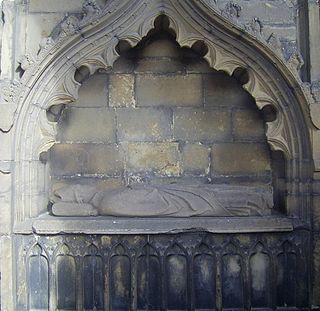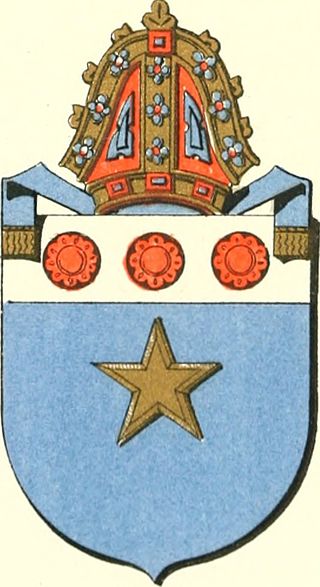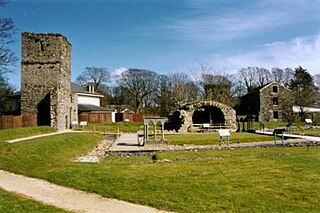Related Research Articles
George Brown was a late 15th-century and early 16th-century Scottish churchman. He first appears on record in 1478 as the rector of the church of Tyningham, and is called a clerk of the diocese of Brechin. In 1482, he was selected to be Chancellor of the diocese of Aberdeen.
Alexander de Kininmund was a 14th-century Scottish churchman. The first mention of Alexander occurs when, as a canon of Dunkeld he is one of three ambassadors sent by King Robert I of Scotland to Avignon in 1320. The purpose of this embassy was to present a letter to Pope John XXII known as the Declaration of Arbroath. As a papal chaplain and lawyer, he was well qualified to argue the Scottish cause, and Barrow makes a strong case that he was, in fact the author of the document.

John de Winchester was a 15th-century English cleric who distinguished himself as an administrator and bishop in Scotland. Winchester was a student of canon law from 1418, graduating with a bachelorate in 1421.

Andrew Stewart was a 15th-century Scottish prelate and administrator.
Thomas de Rossy O. F. M. was a late 14th century Scottish Franciscan friar, papal penitentiary, bishop and theologian. Of unknown, or at least unclear origin, he embarked on a religious career in his early years, entering the Franciscan Order, studying in England and at the University of Paris.
Adam de Lanark, O.P. was a 14th-century Scottish Dominican friar and prelate. Possibly from a Lanark burgess family, he was a Dominican and a priest by 1356, and by 1364 was styled Magister, indicating the completion of a long university education. He first appears in the sources, c. 1355/6 as a confessor of King David II of Scotland; he retained this royal position through the 1350s and into the 1360s; Adam received a number of English safe-conducts to visit King David, who for a time was a prisoner in England.
John of Whithorn was the medieval Bishop of Galloway. His first appearance as bishop-elect is at the coronation of Richard, Cœur de Lion as King of the English at Westminster Abbey on 3 September 1189. He was consecrated at Pipewell Abbey, Northamptonshire, on Sunday 17 September 1189.
Alexander Vaus [Vause, de Vaus] was a late 14th century and 15th century Scottish prelate. Said to have been the younger son of one Patrick Vaus, he apparently held "church livings" in Galloway as early as 1421.
Ingram de Ketenis was a medieval cleric from Angus in Scotland.
Gilbert Cavan was a cleric based primarily in Galloway in the early 15th century, a servant of the earls of Douglas and briefly Bishop of Galloway-elect. His name is also written Caven, Cawan, Caben, with other variants, perhaps representing Gaelic or Irish Cabhan, although the name is not locational, it is a dictus rather than a de name.
Thomas de Buittle [Butil, Butill, Butyll, Butyl, Bucyl] was a Scottish prelate, clerk and papal auditor active in the late 14th and early 15th centuries. Probably originating in Galloway, Scotland, Thomas took a university career in canon law in England and France, before taking up service at the court of Avignon Pope Benedict XIII. He obtained a number of benefices in the meantime, including the position of Archdeacon of Galloway, and is the earliest known and probably first provost of the collegiate church of Maybole. The height of his career came however when the Pope provided him to the bishopric of Galloway, a position he held from 1415 until his death sometime between 1420 and 1422.

David Arnot was a Scottish prelate of the Catholic Church. He was the Bishop of Galloway (Scotland) from 1509 to 1526. He was from the Arnot family of Arnot, Fife.
John Fraser [also, more commonly then, Frisel or Frisell] was a late medieval Scottish prelate. Born about 1429, or 1430 if later tradition can be believed, with strong connections to the burgh of Linlithgow, Fraser held a variety of high-level ecclesiastical positions in Scotland, including being the first Dean of Restalrig collegiate church before becoming Bishop of Ross in 1497, a position he held until his death in 1507.
Thomas Tulloch [de Tulloch] was a prelate active in the Kingdom of Scotland in the 15th century. A letter of Pope Martin V in 1429 claimed that he was "of a great noble race by both parents". Robert Keith believed that he had the surname "Urquhart", but that is not supported by the contemporary evidence and is probably spurious.
John Bullock O.S.A. was an Augustinian canon and prelate active in the 15th century Kingdom of Scotland. While earning a university degree between 1409 and 1417, Bullock gained several benefices in Scotland, and claimed the headship of St Andrews Cathedral Priory before becoming Bishop of Ross in 1418. He held the latter position until his death, which occurred in either 1439 or 1440.
Alexander de Kylwos – written alternatively as Frylquhous, Kylquos, and a variety of other forms – was a Scottish churchman and prelate active in the second half of the 14th century. He is known to have held senior positions in three bishoprics, and senior offices in two, before being elected and appointed Bishop of Ross in 1371. Though his episcopate is relatively obscure, he seems to have spent almost all of it inside or around his province, was closely associated with William III and Euphemia I, successive rulers of Ross, and was an associate of the famous Alexander Bur, Bishop of Moray, during the latter's struggle with Alexander Stewart, the son of the King later known by the nickname "Wolf of Badenoch".
Patrick de Leuchars [also de Locrys or de Lochrys] was a 14th-century administrator and prelate in the Kingdom of Scotland. He first appears in the records in 1344 holding a church in East Lothian, and in 1351 attains national prominence as the new Bishop of Brechin. Bishop Patrick, who would be a core supporter of King David II of Scotland, became Royal Chancellor in the same decade. He held the chancellorship until around 1370, and the bishopric of Brechin until 1383, when he resigned it on account of his old age.
Fionnlagh MacCailein or Finlay Colini was a medieval Scottish bishop. Both his early life and the details of his career as Bishop of Dunblane are not well known, however it is known that he held the latter bishopric between 1403 and his death in 1419. He was part of the circle of Robert Stewart, Duke of Albany, and was one of the many clerics from west and central Gaelic-speaking Scotland who benefited from the latter's patronage. He is said to have authorised the construction of the first bridge over the river Allan at Dunblane.
Dúghall of Lorne [or de Ergadia] was a late 14th century and early 15th century prelate in the Kingdom of Scotland. Probably a MacDúghaill (MacDougall) from the province of Lorne in Argyll, he appears to have studied at the University of Oxford before returning to Scotland for an ecclesiastical and administrative career. He obtained benefices in the diocese of Argyll, Dunkeld, Dunblane and St Andrews, and acted as the secretary and chaplain of Robert Stewart, Earl of Fife, before becoming Bishop of Dunblane. He held the bishopric of Dunblane until his death in 1403.

William Russell was a fourteenth-century Cistercian prelate. He appears to have begun his career as a Cistercian monk at Rushen Abbey on the Isle of Man (Mann), ascending to the rank of abbot there, before being elected Bishop of Mann and the Isles (Sodor). After traveling to Continental Europe for confirmation and consecration, avoiding a trip to the metropolitan in Norway, he returned to the Irish Sea as a legal bishop. A few things are known of his episcopate, particularly his activities in England and a series of provincial statutes apparently promulgated under his leadership.
References
- Brown, Michael, The Black Douglases: War and Lordship in Late Medieval Scotland, 1300-1455, (East Linton, 1998)
- Burns, Charles (ed.), Papal Letters to Scotland of Clement VII of Avignon, 1378-1394, (Edinburgh, 1976)
- Cowan, Ian B. & Easson, David E., Medieval Religious Houses: Scotland With an Appendix on the Houses in the Isle of Man, Second Edition, (London, 1976)
- Dowden, John, The Bishops of Scotland, ed. J. Maitland Thomson, (Glasgow, 1912)
- Keith, Robert, An Historical Catalogue of the Scottish Bishops: Down to the Year 1688, (London, 1924)
- Watt, D. E. R., Fasti Ecclesiae Scotinanae Medii Aevi ad annum 1638, 2nd Draft, (St Andrews, 1969)
